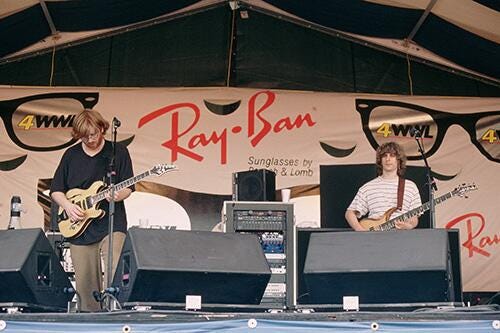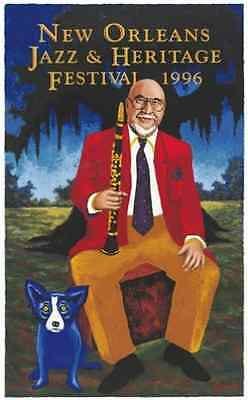SET 1: Ya Mar, AC/DC Bag > Sparkle > Stash, Cars Trucks Buses, You Enjoy Myself -> Wolfman's Brother > Scent of a Mule > Also Sprach Zarathustra > Harry Hood > Sample in a Jar, A Day in the Life > David Bowie
ENCORE: Hello My Baby, Cavern
At the end of 1995, Phish found themselves at an undeniable peak, the triumphant finish line of a 12-year ascent from UVM dorm cafeteria to Madison Square Garden. But the thing about a peak is, no matter which direction you head next, it’s a step downward. You might be able to see another, higher peak somewhere in the distance, but in order to reach that new goal, you’ve got to climb down first. And more often than not, that next peak is shrouded in fog, and even the optimal direction for that decline isn’t immediately clear.
Faced with this dilemma, Phish chose the most logical response: they took time off. A lot of time off, for them — the entire first half of 1996, the longest break from the road in their time as a professional band. Yes, they were recording an album during that time, but even that work was done at a relaxed pace, working most of February and March, taking a month off, and finishing up the session in May and June. Aside from the Surrender to the Air shows, a Bad Hat one-off, two Pork Tornado dates, and a surprise show at a Woodstock bar, the only opportunity for the public to see members of Phish in the first six months of the year was an afternoon set at the storied New Orleans Jazz Fest.
The mid-day booking on the Ray-Ban Stage was an indicator of how Phish would follow up the successes of the prior year. Having reached the apex of the cult rock band hierarchy, selling out some of America’s largest and most famous arenas despite making barely a ripple in the musical mainstream, they consciously looked for new turf to conquer, handicapping themselves along the way. Jazz Fest was the band’s first major multi-act bill since Laguna Seca Daze in 1994 and a couple HORDE dates in 1993, both lineups where they were obvious headliners amongst peers. At Jazz Fest, Phish weren’t even the top act of the day they were booked (the opening Friday), playing setup band in the late afternoon sunlight for The Meters.
Later in the year, they’d take another crack at Europe, where they remained almost complete unknowns, playing low-tier slots on festivals and occasionally even regressing back to their 1992 role as Santana’s warm-up act. Back in America, they played an abridged summer run, just a fortnight of shows leading up to another huge risk: merely the reinvention of the modern American rock festival. It wasn’t until fall tour, when they had a new album to promote, that the band would settle back into familiar patterns,..and even then it didn’t feel quite right (we’ll get to it).
The Jazz Fest set would also set the musical tone for this unusual year. Though many a Phish fan jonesing for their fix made the journey to New Orleans, the band crafted a set that would safely appeal to any of the uninitiated passing by the stage or waiting patiently for The Meters. From Ya Mar and the Michael Ray-featuring Cars Trucks Buses to the one-off acapella intro arrangement of Wolfman’s Brother and the Hello My Baby encore, it was a set drawn from the part of the Phish catalog that would most naturally mesh with the rootsy jazz and groove setting of the festival. Phishy weirdness is kept mostly in check, with the Mule Duel comprising the performance’s most outre segment and the YEM vocal jam tamed into the Wolfman’s intro, and the improvisations are kept tight and firmly in the box. It’s a tasting menu for beginners.
That’s a totally natural low-risk strategy for the historic grounds of the Jazz & Heritage Festival, and in keeping with the band’s usual nerves in NOLA. Apart from a couple composed-part stumbles, they’re surprisingly tight for a group on extended leave; after all, they’ve been up in Bearsville making Blobs together for the last two months. Stash and Hood are firmly Type I but nothing to sneeze at, Bowie has a nice and setting-appropriate jam on Caravan, and the Cars Trucks Buses is probably the stand-out version in that song’s early history.
And yet, as the year’s opening salvo, it’s oddly unsatisfying. 1993 and 1994 kicked off with shows peppered with debuts and giddy with the buzz of a new record. Even the LP-free 1995, which launched with a one-off benefit show, left the blocks with a set that was over 70 percent unheard material. The Jazz Fest set contained no debuts, and only one song (CTB) from the album currently under construction. As an overture for a new year of Phish, it felt ominously like a rerun.
One possible overarching theory of Phish in 1996 is that they were so concerned with adjustments to their typical touring structure, they lost the focus on musical reinvention that defined their first climb to the top of the jamband heap. While the in-progress creation of Billy Breathes would prove to be their most experimental studio accomplishment to date, Jazz Fest suggested a live band that was content to maintain the status quo they had reached in 1995, though significantly minus the confrontational attitude of last summer and the pyrotechnic maximalism of the fall. Exporting the Phish model to new markets was a noble enterprise, but pausing their musical evolution to do so would make the coming year an unusual holding pattern.




